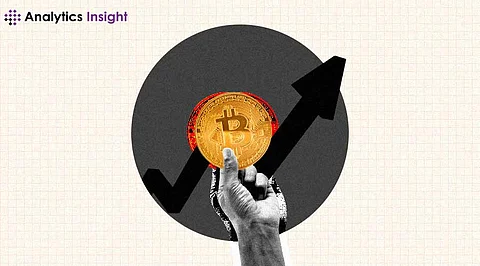

Bitcoin price is trading at approximately $81,484 as of April 11, 2025, representing a modest 0.11% decline over the last 24 hours. The flagship cryptocurrency continues to demonstrate its notorious volatility, with prices fluctuating between $78,626 and $82,001 during intraday trading. Despite a steep 27% drop from its January 2025 peak of over $109,225, Bitcoin's broader market structure remains resilient.
The trading volume and liquidity in Bitcoin markets have held relatively steady, suggesting sustained interest from both institutional and retail participants. A 24-hour trading volume of over $37 billion indicates ongoing investor activity amid mixed macroeconomic and geopolitical signals.
Bitcoin has recorded its largest single-day inflow into accumulation wallets, which typically indicates long-term holding strategies by entities with significant purchasing power. These wallets are known for minimal movement, often regarded as a measure of strong confidence in Bitcoin’s long-term value. Large inflows to such wallets tend to coincide with market bottoms or correction phases, marking potential support levels.
Whale activity and on-chain data continue to reflect cautious optimism. A notable uptick in accumulation during price dips demonstrates that major holders are treating the recent correction as a strategic buying opportunity rather than a signal to exit.
Today marks the expiry of approximately $2.59 billion worth of Bitcoin and Ethereum options contracts. With the max pain point for Bitcoin sitting at $82,000, traders can expect heightened price fluctuations. The max pain point refers to the price at which the highest number of options contracts expire worthless, and it often acts as a magnet for price action near expiry dates.
Historically, large-scale expirations tend to cause short-term volatility, as market makers and traders adjust positions to minimize losses or maximize gains. Such expiries also create short-lived liquidity gaps that may influence trading decisions across the broader cryptocurrency market.
In a landmark move, President Donald Trump repealed an IRS rule that had previously classified decentralized finance (DeFi) platforms and wallet providers as “brokers” for taxation purposes. The original rule, introduced in 2021, sought to enforce stringent KYC and reporting standards on platforms that operated without centralized control.
The repeal signifies a major shift in regulatory sentiment, promoting a more business-friendly environment for crypto innovation in the United States. This deregulation is seen as a tailwind for Bitcoin, as it could encourage greater participation from U.S.-based developers and investors.
In another groundbreaking policy move, the U.S. government has confirmed the establishment of a Strategic Bitcoin Reserve, modeled after the Strategic Petroleum Reserve. With approximately 200,000 BTC under management, the initiative aims to secure a foundational stake in digital assets as part of national financial strategy.
This institutional validation of Bitcoin as a reserve asset highlights the shifting perception of cryptocurrencies. It reflects a broader geopolitical trend where nation-states are gradually recognizing Bitcoin not only as a store of value but also as a hedge against sovereign risk and inflation.
Bitcoin price remains sensitive to global macroeconomic factors, especially geopolitical conflicts. The latest escalation in the U.S.-China trade war—marked by China imposing 125% tariffs on U.S. imports—has rattled global markets. Equities in Asia and the U.S. have responded with broad selloffs, pushing investors toward alternative assets such as cryptocurrencies.
Bitcoin, often described as "digital gold," tends to benefit during periods of geopolitical unrest and trade disputes. Investors look to Bitcoin to hedge against the instability of fiat currencies and traditional financial systems.
The recent decline in the U.S. Dollar Index (DXY) has added fuel to Bitcoin’s recent resilience. As the dollar has weakened due to inflationary pressures and shifting interest rate expectations, investors have increased exposure to crypto as a means of value preservation.
A weakening dollar often drives capital into non-dollar denominated assets, particularly those considered to have finite supply, such as Bitcoin. The correlation between Bitcoin and the dollar remains inverse, making the current macro environment supportive of price stabilization or potential upward momentum.
Bitcoin is currently trading in a tight range, attempting to break past resistance near $83,700. If this resistance level is successfully breached with volume support, a move toward $87,000–$90,000 could follow. However, maintaining support above $78,464 remains critical to avoid deeper corrections.
Key indicators reflect a mixed sentiment:
Short-term (7-day): Bitcoin has declined by approximately 3.03%
Medium-term (30-day): The asset shows a downward trend of around 11.5%
Long-term (6-month): Gains still stand strong at 26.53%
The Relative Strength Index (RSI) currently sits near 48, suggesting a neutral market, with neither extreme oversold nor overbought conditions. The MACD (Moving Average Convergence Divergence) shows convergence with a slight bullish tilt, indicating possible upward movement if broader sentiment improves.
Despite near-term challenges such as geopolitical tensions, macroeconomic instability, and regulatory transitions, Bitcoin continues to consolidate above key psychological levels. Strong accumulation trends, bullish on-chain metrics, and strategic government involvement paint an encouraging picture for the asset’s long-term trajectory.
Institutional interest remains high, and major corporations are reportedly exploring the addition of Bitcoin to their balance sheets amid mounting concerns about inflation and fiat devaluation. Simultaneously, retail adoption is growing through better accessibility, improved mobile apps, and educational outreach.
If macroeconomic conditions stabilize and global monetary policies remain accommodative, Bitcoin could witness a renewed rally toward the $90,000 to $100,000 range in the second quarter of 2025.
Bitcoin price action on April 11, 2025, is reflective of broader market uncertainty and investor recalibration. Key developments—including the repeal of controversial regulations, the launch of a strategic reserve, and rising accumulation—signal strengthening fundamentals. While short-term volatility persists, the long-term investment narrative for Bitcoin remains robust, driven by its scarcity, decentralization, and growing global relevance.
